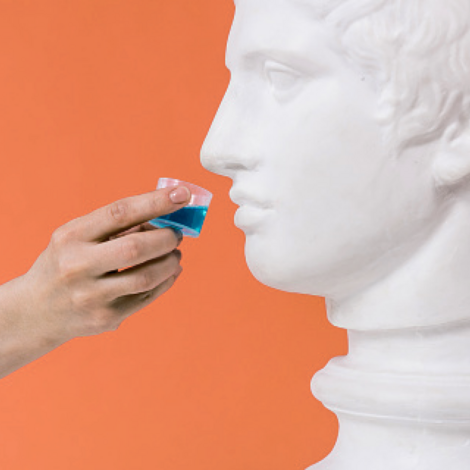There you are, minding your own business as you shop for fragrance. You gaze over the familiar, elegant Chanel Coco Mademoiselle, Dior J’Adore, Portrait of a Lady, and Carolina Herrera Good Girl, moving on to Bistro Waters and Oyster. Oyster?
After decades of sugary-sweet perfumes getting all the love, fragrances are moving to the dark side, where food is still the focus but the flavors are far from conventional. “The world of gourmand now includes scents that are taste-related, but not necessarily always sweet,” says Rodrigo Flores-Roux, the vice president of perfumery at Givaudan. “These perfumes appeal particularly to the taste buds.”
The new savory scents conjure up the aromas of soy sauce, olive oil, and artichokes, among others, stimulating jaded palates with provocation and oddness. According to Flores-Roux, “people want to diversify and experiment. It’s kind of cool.”
The trend toward perfumes with an edible quality was fueled in 1992 with the launch of Angel by Thierry Mugler, a marshmallowy vanilla fragrance by the master perfumers Olivier Cresp and Yves de Chirin. But now gourmand scents, as the category is known, are stepping out of the cupcake factory and into the world of fine dining, with perfumes based on herbs, grains, milk, and umami-like notes.
Is it peculiar to walk around smelling like dinner? David Seth Moltz, a co-founder of D.S. & Durga, doesn’t think so, given his Bistro Waters eau de parfum. Before he was a perfumer, Moltz worked at the raw vegan restaurant Pure Food and Wine (yes, the chaotic New York spot that’s portrayed in the Netflix docuseries Bad Vegan) and says Bistro Waters “captures some of the fresh green notes of the era in a savory perfume water of green pepper, basil, lime, and pea flower.”
Artichoke and carrot seeds are some of the more unusual notes in Bottega Veneta’s new Come with Me, which mixes them with more traditional vanilla, bergamot, and powdery orris butter, from the iris root. The bottle, a sculptural bubbled glass, sits on a base of green marble as if it’s an objet d’art. A Grove by the Sea, by Arquiste, blends olive oil with rosemary, thyme, and Adriatic fig, which sounds like the beginning of a Mediterranean dish.
In a similar territory, Hermès perfumer Christine Nagel combines the nutty aroma of toasted cereal with a milky quality in Un Jardin à Cythère, a scent she describes as comforting.
Green Vanille, the newest scent from Regime des Fleurs, also has a “gentle wheat-like quality that’s both soothing and addictive,” says Alia Raza, founder and artistic director of the house. With hazelnut and almond, coriander, and vanilla that could be found in the kitchen, she insists, “this is not a dessert perfume. It’s a grown-up, savory, herbal vanilla.”
It may seem as if perfumers are grasping for inspiration, however illogical, to feed the novelty seekers on PerfumeTok. Moltz concocted a Pasta Water candle with Juniper, the Rockefeller Center restaurant, that smells exactly as advertised, with notes of salt water and semolina. His Pistachio eau de parfum inspired the mixologist at Pulitzer’s Bar in Amsterdam to create a cocktail that balances “warmth and brightness, indulgence and intrigue,” according to the menu.
From there, it gets truly strange. Jang from Elorea, a perfume based on Korean fermented sauces, is polarizing, according to Su min Park, a co-founder of the brand, given its blend of soy sauce and charcoal with jasmine and myrrh.
And even more divisive, at least in name, is Oyster, a scent from Les Elixirs. As created by Flores-Roux, it has a crisp, refreshing brininess mixed with lychee, honeysuckle, and spices. “It’s a very specific smell that is very alive; it’s animalic; it reminds you of oysters, but also the sea and the bayou and the swampiness,” says Flores-Roux. Wearing it almost seems like a dare.
As oddball as these elements sound, many of them have been hiding in plain sight. “Peppers, olives, and other savory notes have been infused into scents before, layered beneath other notes,” says Linda G. Levy, president of the Fragrance Foundation. Moltz, restlessly creative, says, “Perfumers are using them in newer, bolder ways. You might have used a savory green molecule to support a flower perfume, and no one knew. But now we might use a flower to support something that smells like bell peppers. The world is much more open to the fact that perfume is a wearable art form, and you can express entire worlds with its power.”
There’s clearly a limit to the appeal of savory scents, but, for now, a small but enthusiastic audience isn’t full yet. Maybe, in the era of Ozempic, these food aromas supply a necessary distraction.
Kristin Limoges is a New York–based beauty writer. Her work has appeared in Harper’s Bazaar, Allure, WWD, and InStyle, among other publications





